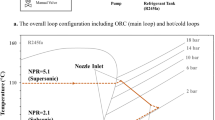Abstract
In this study, the characteristics of oscillating pressure-driven flow in a microdiffuser are examined by μPIV (micro Particle Image Velocimetry) diagnostics. Utilizing a cam-follower system, a dynamic pressure generator is built in-house to provide a time-varying sinusoidal pressure source. Three parameters are examined experimentally: the excitation frequency, the cam size, and the half-angle of the microdiffuser. Driven by oscillating pressure, we find that there exists an optimal half-angle such that maximum net flow is attained in the expansion direction. Contrarily to the prediction of hydraulics theory which only considers steady flow, flow in the microdiffuser of the optimal half-angle does not necessarily remain attached. Rather, maximum net flow can also occur in microdiffusers where vortices retain a slender shape. When vortex bubbles are slender, the μPIV results reveal that the core flow accelerates to a higher forward velocity during the first half of the cycle and flow rectification is actually enhanced. Due to the three-dimensional flow structure, fluid is drawn out of the vortices near the reattachment point to join the core flow and consequently magnifies the forward flow. As the half-angle increases, vortices become rounder and the core flow is drastically narrowed to reduce flow rectification.












Similar content being viewed by others
Abbreviations
- d t :
-
Inner diameter of the Teflon tube
- D :
-
Microchannel depth
- D h :
-
Hydraulic diameter of the throat
- d p :
-
Diameter of seeding particles
- e :
-
Spatial resolution
- f :
-
Excitation frequency
- M:
-
Magnification
- n :
-
Refractive index
- NA:
-
Numerical aperture
- P :
-
Instantaneous pressure
- P 0 :
-
Pressure amplitude
- Q :
-
volume flow rate
- R :
-
Tensor invariant
- s m :
-
Net displacement of the meniscus in the Teflon tube
- ∆t :
-
Circulation lifetime
- t :
-
Time
- t m :
-
Time interval
- T :
-
Period
- u :
-
Streamwise velocity
- W inlet :
-
Width of the inlet
- w :
-
Corresponding microchannel width at x
- x :
-
Streamwise coordinate
- y :
-
Transverse coordinate
- ε:
-
Threshold value (ε = 0.01)
- δDOC :
-
Depth of correlation
- δDOF :
-
Depth of field
- δm :
-
Depth of measurement
- ∆:
-
Discriminant of velocity gradient tensor
- λ:
-
Wavelength of incident light
- μ:
-
Dynamic viscosity of the working fluid
- θ:
-
Half-angle of the microdiffuser
- ρ:
-
Density of the working fluid
- inlet:
-
Inlet
- opt:
-
Optimal
References
Batchelor GK (1977) The effect of Brownian motion on the bulk stress in a suspension of spherical particles. J Fluid Mech 83(1):97–117
Chong MS, Perry AE, Cantwell BJ (1990) A general classification of three-dimensional flow fields. Phys Fluids A 2(5):765–777. doi:10.1063/1.857730
Einstein A (1987) The collected papers of Albert Einstein. The Swiss years: writings, 1909–1911, vol 3. Princeton University Press, Princeton, NJ
Fan C, Chao B-T (1965) Unsteady, laminar, incompressible flow through rectangular ducts. Z Angew Math Phys 16(3):351–360
Inoué S, Spring KR (1997) Video microscopy: the fundamentals, 2nd edn. Plenum, New York
ISA (2002) A guide for the dynamic calibration of pressure transducers. The instrumentation, systems, and automation society, Research Triangle Park
Kloosterman A, Poelma C, Westerweel J (2011) Flow rate estimation in large depth-of-field micro-PIV. Exp Fluids 50(6):1587–1599. doi:10.1007/s00348-010-1015-9
Loudon C, Tordesillas A (1998) The use of the dimensionless Womersley number to characterize the unsteady nature of internal flow. J Theor Biol 191(1):63–78. doi:10.1006/jtbi.1997.0564
Meinhart CD, Wereley ST, Gray MHB (2000) Volume illumination for two-dimensional particle image velocimetry. Meas Sci Technol 11(6):809–814
Nabavi M (2009) Steady and unsteady flow analysis in microdiffusers and micropumps: a critical review. Microfluid Nanofluid 7:599–619. doi:10.1007/s10404-009-0474-x
Nabavi M, Mongeau L (2009) Numerical analysis of high frequency pulsating flows through a diffuser-nozzle element in valveless acoustic micropumps. Microfluid Nanofluid 7:669–681. doi:10.1007/s10404-009-0427-4
Norton RL (1992) Design of machinery, 1st edn. McGraw-Hill, New York
Ohmi M, Iguchi M, Usui T (1981) Flow pattern and frictional losses in pulsating pipe flow. Part 5: wall stress and flow pattern in a laminar flow. Bull JSME 24 (187):75–81
Olsen MG, Adrian RJ (2000) Out-of-focus effects on particle image visibility and correlation in microscopic particle image velocimetry. Exp Fluids 29:S166–S174. doi:10.1007/s003480070018
Peker SM, Helvacı ŞŞ (2008) Solid-liquid two phase flow. Elsevier, Oxford
Sheen HJ, Hsu CJ, Wu TH, Chang CC, Chu HC, Yang CY, Lei U (2008) Unsteady flow behaviors in an obstacle-type valveless micropump by micro-PIV. Microfluid Nanofluid 4(4):331–342. doi:10.1007/s10404-007-0189-9
Sherwood L (2009) Human physiology: from cells to systems, 7th edn. Brooks Cole, Belmont, CA
Singhal V, Garimella SV, Murthy JY (2004) Low Reynolds number flow through nozzle-diffuser elements in valveless micropumps. Sens Actuat A Phys 113(2):226–235. doi:10.1016/j.sna.2004.03.002
Smit AJ, Lim TT (2000) Flow visualization: techniques and example. Imperical College press, London
Sun C-l, Huang KH (2006) Numerical characterization of the flow rectification of dynamic microdiffusers. J Micromech Microeng 16(7):1331–1339. doi:10.1088/0960-1317/16/7/030
Sun C-l, Yang ZH (2007) Effects of half angle on the flow rectification of a microdiffuser. J Micromech Microeng 17(10):2031–2038. doi:10.1088/0960-1317/17/10/015
Tanaka S, Tsukamoto H, Miyazaki K (2008) Development of diffuser/nozzle based valveless micropump. J Fluid Sci Technol 3(8):999–1007. doi:10.1299/jfst.3.999
Wang Y-C, Hsu J-C, Kuo P-C, Lee Y-C (2009) Loss characteristics and flow rectification property of diffuser valves for micropump applications. Int J Heat Mass Transfer 52(1–2):328–336. doi:10.1016/j.ijheatmasstransfer.2008.06.010
Acknowledgments
This work is supported by the National Science Council of Taiwan under grant number NSC 93-2212-E-011-017 and NSC 94-2212-E-011-039.
Author information
Authors and Affiliations
Corresponding author
Rights and permissions
About this article
Cite this article
Sun, Cl., Lee, HC. & Kao, RX. Diagnosis of oscillating pressure-driven flow in a microdiffuser using micro-PIV. Exp Fluids 52, 23–35 (2012). https://doi.org/10.1007/s00348-011-1204-1
Received:
Revised:
Accepted:
Published:
Issue Date:
DOI: https://doi.org/10.1007/s00348-011-1204-1




